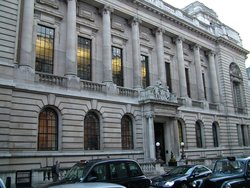Institution of Civil Engineers
|
|
Founded on 2 January 1818, the Institution of Civil Engineers (the ICE) is an independent professional association, based in central London, representing civil engineers. Like its early membership, the majority of its current members are British engineers, but it also has members in more than 100 countries around the world. In 2003, its total membership stood at around 80,000. In 2004, Colin Clinton assumed office as the current President.
| Contents [hide] |
Purpose
As a professional body, it is committed to support and promote professional learning (both to students and existing practitioners), managing professional ethics and safeguarding the status of engineers, and representing the interests of the profession in dealings with government, etc. It sets standards for membership of the body; works with industry and academia to progress engineering standards and to advise on education and training curricula; publishes technical studies of aspects of civil engineering, and publishes a weekly magazine, the New Civil Engineer.
Students pursuing recognised academic courses in civil engineering can join the ICE as student members. After completing their studies, individuals can become graduate members – a step closer to achieving full Member status (MICE). The pinnacle of professional standing is to then be accepted as a Fellow.
Origins
The late 18th century and early 19th century saw the founding of many learned societies and professional bodies (for example, the Royal Society and the Law Society). Groups calling themselves civil engineers had been meeting for some years from the late 18th century, notably the Society of Civil Engineers formed in 1771 by John Smeaton (renamed the Smeatonian Society after his death). However, apart from groups centred upon universities and other centres of learning such as military engineering academies (eg: the Royal Military Academy at Woolwich) and Mechanics Institutes, there was no body promoting the profession of civil engineering.
The initiative to found the Institution was taken in 1818 by three young engineers, Henry Robinson Palmer (23), James Jones (28) and Joshua Field (32), who organised an inaugural meeting on the 2nd January 1818, at the Kendel Coffee House in Fleet Street. The institution made little headway until a key step was taken - the appointment of Thomas Telford as the first President of the body. Greatly respected within the profession and blessed with numerous contacts across the industry and in government circles, he was instrumental in drumming up membership and getting a Royal Charter for the ICE in 1828. This official recognition helped establish the ICE as the pre-eminent organisation for civil engineers.
After Telford’s death in 1834, the organisation moved into premises in Great George Street in the heart of Westminster in 1839, and began to publish learned papers on engineering topics. Its members, notably William Cubitt, were also prominent in the organisation of the Great Exhibition of 1851.
In some respects the ICE was ahead of its time, providing a focus for engineers from other disciplines. Mechanical engineer and tool-maker Henry Maudslay was an early member and Joseph Whitworth presented one of the earliest papers – it was not until 1847 that the Institution of Mechanical Engineers was established (with George Stephenson as its first President).
By the end of the 19th century, the ICE had introduced examinations for professional engineering qualifications to help ensure and maintain high standards among its members – a role it continues today.
Past ICE Presidents
Many of the profession’s greatest engineers have served as President of the ICE including:
- Thomas Telford (1820-1834 – the post later became a biennial and then annual accolade)
- James Walker (1834-45)
- Sir William Cubitt (1851)
- Robert Stephenson (1855)
- Joseph Locke (1857)
- Sir John Fowler (1865)
- Thomas Hawksley (1871)
- William Henry Barlow (1879)
- Sir Joseph Bazalgette (1888)
- Sir John Wolfe-Barry (1896)
- Sir Alexander Binnie (1905)
- Sir William Halcrow (1944)
Sadly, arguably Britain's greatest engineer Isambard Kingdom Brunel died before he could take up the post (he was vice-president from 1850).
Reference
- Charles Matthew Norrie (1956). Bridging the Years - a short history of British Civil Engineering. Edward Arnold (Publishers) Ltd.
External link
- ICE website (http://www.ice.org.uk/)

